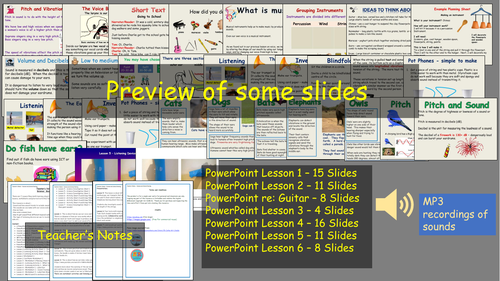



UPDATED WITH ANSWER SHEETS AND TEACHER NOTES MAY 2019
There are 7 Lesson Plans (with learning objectives) and Presentations. Worksheets and practical activities for whole group teaching. Please see Preview Panes.
The pack consists of:
-Sound and how sound travels including sound waves, vibrations, pitch, volume;
-The sounds we can make with our voices and what happens;
-How we hear;
-How some animals hear;
-How to get sound from different musical instruments and what happens; and
-The type of listening devices we use to locate sound, stethoscopes, hearing aids etc.
- 19 audio sounds for listening activities (MP3 audio)
Lesson 1: This is about how we use our voice and the different sounds we make. There is a diagram of how our voice works which includes vibration, pitch and how we need our teeth and tongue to produce sounds.
Activity: students are given a very short text to add vocal sound effects to in their groups - narrator/reader reads the short text (print this off the Slide) and the other students decide on vocal sound effects to add.
Lesson 2:- This is about musical instruments and how we produce sound from them (bang, hit, shake, pluck etc.) and group them into their categories (wind, stringed, percussion)- Grouping Activity sheets and Listening activity.
Lesson 3 - This is more practical and students plan and design their musical instruments. They are given ideas on what to do, e.g. make a guitar from cereal boxes, the handle is made of kitchen towel tube, strings are various sizes of elastic bands etc.
Lesson 4: This is about how we ear (also video youtube link - Children learn about the anatomy of the ear (outer ear, middle ear and inner ear) and how we receive and process sound. They also learn about why we get dizzy (semi-circular canals in our ear is filled with fluid).
There are worksheet activities and Listening activities on PowerPoint Presentations.
Lesson 5: This lesson is about different listening devices such as the stethoscope, ear trumpets that were used in the past and versions of it that are used to hear unborn babies. Students: make ear trumpets and pot telephones learning how sound travels to the ear via the string attached to the plastic cups. Students test different cups and length of strings.
Lesson 6: This lesson is about how some animals move their ears to hear sounds and locate their prey. - Activities: Students work with a partner to complete their worksheets with missing words.
Lesson 7: Investigation - Explores sounds get quieter when you are further away from its source - Sounds for Kids
All the lessons include information on volume, pitch, vibrations and sound waves.
All lessons contained in a .zip file - PowerPoint, PDF and MS Word files.
This is a US version. Please see UK version
Thank you for visiting my store.
Something went wrong, please try again later.
This resource hasn't been reviewed yet
To ensure quality for our reviews, only customers who have purchased this resource can review it
Report this resourceto let us know if it violates our terms and conditions.
Our customer service team will review your report and will be in touch.